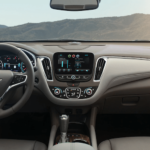A lot goes into the car-buying experience. On the buyer’s side alone, a satisfying purchase is the reward enjoyed by a buyer who has performed their due diligence. They have made the decision to pursue a new or used vehicle offering. They have researched the pros and cons of makes, models and trim levels. They have sourced the financing option that best suits them. They might even have zeroed in on a specific dealership to do business with. But for those in search of a new model year offering, another consideration is the determination as to whether they’re best served by buying or leasing a vehicle. With that in mind, it’s important to understand the unique value in each automaker’s lease programs. For example, if you’re looking to get behind the wheel of a new GMC Terrain it’s important to understand the GMC lease deals that you’re eligible for.
But how do you know whether it’s buying or leasing that best suits the unique demands of your lifestyle? It’s been quite some time since leasing was reserved solely for the luxury segment, business fleets, or the wealthy. That said, it might be the perfect option, depending on where your priorities fall.
But what if you’re not fiscally-minded, well-informed or (dare we use the vernacular of the millennial) less-adept at ‘adulting’? Well, we can help. So, let’s explore the fundamentals of leasing, the benefits, the pitfalls, and the differences between leasing and buying. And if we do our job well enough, you’ll have a much better understanding as to which option you wish to pursue. But first…
What is Leasing?
Don’t be insulted; fundamentals are important, so there’s no shame in familiarizing ourselves with the fundamentals of leasing. As with financing a car, leasing one is a means of securing it without paying the full amount required in order to purchase it.
The difference is that financing a vehicle calls for its total cost to be amortized across the duration of the financing period, increased further by the annual percentage rate of interest that the buyer has been approved for. Leasing a vehicle calls for the lessee to pay for the vehicle’s depreciation over the terms of the lease, plus interest and any fees that might apply.
Leasing 101
The decision to purchase a vehicle is an admirable one, but there’s no escaping the fact that you’re investing in a depreciating asset. Vehicles begins to lose value the moment it’s driven off the lot (to the tune of 11% before the rear tires even hit the pavement). For that reason, leasing becomes a favorable option based solely on the reduced cost and commitment.
By leasing, you gain the freedom of making a short-term commitment to a vehicle (24 or 36 months, is a fairly normal minimum), paying less overall, and the ability to return it to the dealership once complete. At that time, you can opt to enter another lease agreement, allowing you to drive new (or newer) vehicles at all times. For some people this is an important consideration as their vehicle might be related to professional image; while others might just like having all the newest bells and whistles. Either way, leasing is a way to afford a vehicle one might not otherwise be able to afford.
That said, this might be the first of numerous times that we reiterate the fact that leasing programs differ from one another. From duration to built-in costs, to terms and responsibilities, all programs are built differently. Thus, it’s important to do your homework before deciding if it’s the right fit for you.
 Pros of Leasing
Pros of Leasing
Outside of driving the latest and greatest, here’s a brief rundown of some of the other advantages of leasing a new vehicle:
- Smaller Down Payment – A lease contract normally includes some negotiation as to the downpayment, but they’re almost always less than what is expected of a financed buyer. Furthermore, a down payment might not even be asked of a well-qualified lessee.
- Absence of Sales Tax – Depending on where you live, sales tax can be an ugly little surprise that rears its head to rub the salt in the wound that is a huge purchase. The rules differ based on geography, but it’s not unusual for the tax applied to a lease to be significantly lower.
- Lower Monthly Payments – We’ll spend a little more time talking about this, but more money in your pocket or bank account is rarely a bad thing.
- Warranties & Scheduled Maintenance – Since a major focus of a lease agreement is to help the vehicle retain as much value as possible, maintenance is key. Part of any agreement will be a scheduled maintenance program, requiring periodic visits to the dealership. That said, many of the costs associated with preventative maintenance (or even repair) will be covered under warranty.
- Ease of Trade-In – We mentioned this above, but imagine the ease of driving up, handing the keys over and moving onto your next vehicle. Sure, there are vehicle inspections, papers to sign, and (for some) the possibility of surcharges but the close of a lease agreement really can be that easy.
That said, it’s not all sunshine and roses. There are, of course, downsides to leasing.
Credit Requirements – we’ve all heard the term ‘well-qualified lessee’ (in fact, we’ve even used it here). Simply put, not everyone will qualify for certain lease programs.
- No Ownership – A lessee is merely the temporary guardian of a vehicle. They have no claim to the vehicle, or equity in it. They have no right to modify the vehicle in any permanent way, and may even be restricted on how and when they can drive it (out-of-country restrictions, for example).
- Mileage Restrictions – Every agreement includes a limitation on the mileage you can incur. Exceeding the allotted mileage might lead to a charge of 15-30 cents per mile, a cost that can add up quick.
- Potential Surcharges – In addition to mileage surcharges, a lessee is held responsible for any and all damage, outside of normal wear or tear to a vehicle. From nicks in the paint, to soiled upholstery, the rigors of regular driving can prove costly.
- No Cash Return – It ’s another flip side of the easy return, the fact that a lease agreement contributes nothing to your next vehicle. There is no cash return for a downpayment. Each and every lease agreement is unique to itself.
- Additional Insurances – You might be required to purchase gap insurance, ensuring that the vehicle is covered in the event that it’s unexpectedly totaled.
All in all, it’s easy to appreciate both the pros and the cons, but what about cost?
The Bottom Line
Imagine that you’re interested in a $25,000 car.
- If ‘Option 1’ is paying cash, the total cost will be $25,000 plus around $1,825 combined in tax, title and additional fees.
- If ‘Option 2’ is financing a vehicle, the numbers will be affected by your credit score and downpayment. Let’s say you have an excellent credit score, and you’re looking for 60-month financing with a downpayment of $2,500. With a 4.5% APR the monthly payment could fall in around $453.
- And if ‘Option 3” is leasing the $25,000 vehicle for 36-months, the monthly payment (taking into consideration Residual Value, Money Factor, Acquisition Fee, etc) might equate to a difference of hundreds of dollars. There are also timed promotions offered by automakers, to further incentivize lease programs.
So, as you can see there the likelihood of a significant difference in the monthly payments expected by a financed buyer and a well-qualified lessee. In addition, the lessee is only entering into a 36-month contract while the buyer will be making those payment for 60-months.
Is Leasing Right For You?
Only you can decide for sure. Hopefully, we’ve given you something to think about.



